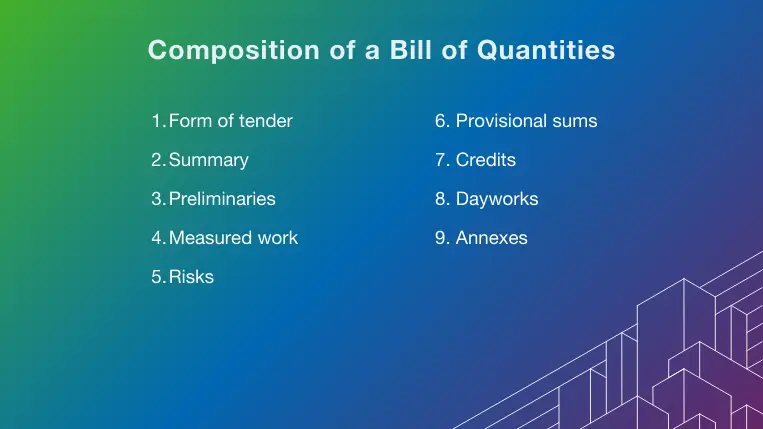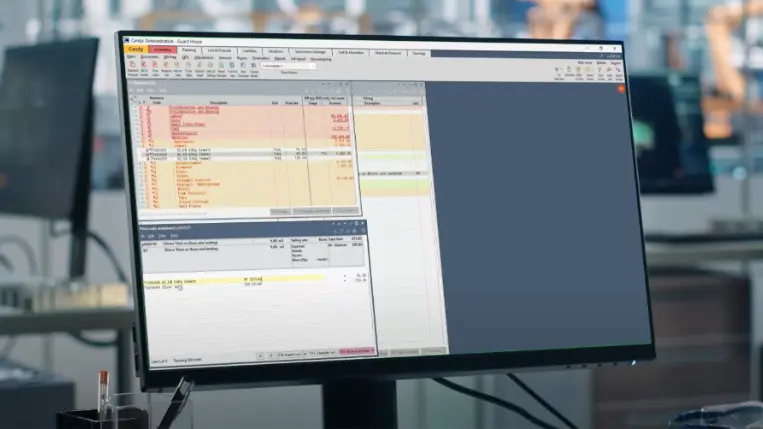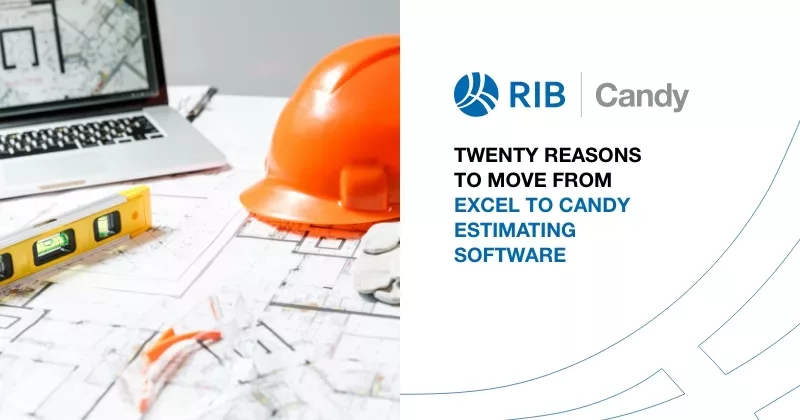10 mins read
Exploring Bill of Quantities: Everything You Need to Know

What separates a successful construction project from a failed or break-even build?
Well, there are really too many factors to discuss in a single post. However, one of the most critical aspects to consider is thorough planning. If you aim for efficiency, cost control, and intelligent resource allocation, it all starts with a carefully thought-out plan. And a plan begins with a comprehensive list of the extent of work that needs to be carried out. After all, the entire project depends on having an accurate blueprint of all the components that will bring it to life.
That is where a Bill of Quantities (BoQ) comes in. This invaluable document provides descriptions and firm quantities of the work comprised in a contract. It is a crucial tool during the bidding process.
This RIB blog post will explore their importance, advantages, best practices, and more.
Let’s start with the Bill of Quantities meaning!
What Is a Bill of Quantities?
A Bill of Quantities (BoQ) is a document listing the items and quantity of work required to complete a project. It includes a description and a measure that allows the work to be priced, and it is handed over to contractors as a key element of the tender documentation.
The RICS’s New Rules of Measurement 2 (NRM2) defines a Bill of Quantities as “a list of items that gives detailed identifying descriptions and firm quantities of the work comprising a contract.” This is illustrated in the image below, showing a BoQ in RIB Candy software.

The work described in the BoQ is defined using different Methods of Measurement, each with a set of rules identified by the item descriptions. The chosen method will also specify how the work should be categorized, which in most building projects is by trade.
Generally, BoQs are drawn up by the quantity surveyor, an architect, or an engineer after the project design and specifications are completed. They are mainly used in construction for large, complicated projects requiring a more complex tendering process.
Usually, bidding contractors receive the BoQ as part of the tender documents. This ensures all contractors are pricing the work based on the same information, allowing for easier and faster bid comparisons. In that sense, an accurate construction Bill of Quantities is valuable for both the project owner and the contractor.
The construction BoQ provides sufficient information for the tenderers to calculate costs, such as the manufacturing and delivery of materials, plant, labor, and other associated costs. It also itemizes the work involved so it will be carried out on a less confrontational basis, the owner will be satisfied, and any potential wastage along the way will be reduced. Contractors might also do their own quantity remeasurements using modern 3D takeoff software. If discrepancies are found, the contractor may submit a Request for Information (RFI) to the owner’s Consultant or Engineer to clarify.
From the owner’s side, a BoQ reassures owners that every aspect of the project is accounted for, allowing for accurate cost forecasting and budgeting. They are also valuable during the construction period, as they help prepare interim valuations, assist with work variations, and prepare the final account, among other things.
BoQ vs. BoM
Sometimes, people confuse a construction Bill of Quantities with a Bill of Materials (BoM). While both documents are similar, they differ in their application and focus.
A BoM only outlines the materials needed to complete a project. They help in cost estimation and efficient resource planning. A BoQ, on the other hand, outlines and describes the work required to complete the project.
In some cases, general contractors provide a work package BoQ when choosing subcontractors for building projects. Subcontractors can also request an RFI if they find discrepancies in the BoM.
Importance & Purpose of Bill of Quantities

Now that we have explored the definition, let’s examine the benefits and importance of a bill of quantities.
Simplified and efficient tendering
As mentioned previously, one of the main benefits and purposes of a Bill of Quantities is to ensure an accurate and fair bidding process. Having this as a standard document ensures that competing contractors price the project on the same basis, thus reducing the risk of ambiguity through omissions or misunderstandings. Plus, it saves the owner and their team hours analyzing bids, as comparisons are way easier if everyone bids based on the same quantities.
Having this solid document makes quantifying the work much easier and more transparent. This needs to occur during the construction procurement process of any project to get accurate prices or to value the work for payment. Therefore, producing an effective BoQ is essential for a successful bidding process. Getting it right can help contractors provide better service and win over more clients.
Planning & scheduling
Another key advantage of a BoQ is that it enhances planning and scheduling. The information about the work to be completed provided by the BoQ can be linked with the project plan, which offers time-related information, to achieve better planning. This will help deliver the project within the expected timeline and avoid any waste of equipment, labor, or materials. Likewise, the project’s owners can have an accurate overview of what will happen at each stage.
Communication, accountability & transparency
A BoQ provides a comprehensive overview of works, which makes it the perfect tool to ensure effective communication, accountability, and transparency between the owner and the contractor. A clear layout of tasks and costs organized in a defined timeline reduces the chance of mistakes or misunderstandings, and it saves both parties time by avoiding unnecessary meetings. Additionally, it boosts accountability and transparency as the project owner can keep track of all costs and put them in the context of the BoQ to confirm that the budget is being spent appropriately.
Once it is priced, the BoQ also proves invaluable for contract management. It is a reliable source for valuing variations, interim payments, and the final account, making the owner-contractor relationship much more transparent and healthy throughout the contract.
Cost control
A well-constructed BoQ provides project owners and contractors with accurate cost control. A detailed overview of items and their prices can help identify the most costly ones and look for alternatives to ensure the budget is respected. During construction, the document gives visibility into upcoming expenses to help with resource management. Additionally, if any unexpected modifications happen due to a change in the design, the organized format of this document makes it easy to price variations and adapt the budget accordingly.
Analysis, collection & storage of cost data
Once the BoQ is priced, it serves as an invaluable source of cost data. Quantity surveyors or cost professionals can use a priced BoQ to provide professional advice about the potential costs of future building projects. The cost data from a priced BoQ can be retrieved and stored to be analyzed in different ways and applied for cost estimation or benchmarking purposes, among other things.
Risk management & contingency planning
A well-structured BoQ provides a detailed breakdown of the work to be carried out, facilitating the early identification of potential challenges and the implementation of contingency plans. For example, a specific task like excavation and earthworks, historically more prone to error or changes, might need an exclusive contingency budget. This proactive approach not only helps maintain budgetary control but also ensures that the project can adapt to changes without significant disruptions.
Composition of a Bill of Quantities

Understanding a Bill of Quantities is essential for anyone involved in planning, estimating, or procurement. The composition might vary for different projects, measurement standards, and software providers. For this post, we will use the standardized structure from the RICS New Rules of Measurement 2 (NRM2).
Form of tender: This is a separate document where the tenderer can provide details about their proposal, including name, address, and tender price. If the tenderer wins the bid, the tender price will become the “contract sum”. In some cases, an additional document called a “certificate of bona fide tender” might be included as a commitment that the main contractor has not communicated their tender to other parties.
Summary: As its name suggests, the summary comprises all the individual sections of the BoQ with totals for each section, such as preliminaries, measured works, provisional sums, etc. The summary adds up the costs from all sections, and the total is then written down in the Form of Tender. After the client reviews and verifies the total (and makes adjustments if needed), it becomes the official contract sum recognized in the legal contract.
Preliminaries: This section is used to inform potential contractors about items that are not directly related to a work section, such as security, safety, environmental protection, and site establishment, among other overhead costs. Preliminaries are usually divided into two sections: information and requirements, which describe general project info, contractual obligations, and client expectations; and pricing schedule, where the contractor enters the cost for the preliminary activities.
Measured work: It is the most important component of a BoQ, listing all the work items to be completed with a detailed description, a unit of measurement, and quantities. Items of work include excavations, concrete placement, masonry, and much more, depending on the project. Units of measurement include number, length, area, volume, weight, and time.
Risks: This section lists residual risks the owner wants to transfer to the contractor. The contractor must provide a lump sum fixed price for handling the potential risks if they become a reality. Examples include the disposal of contaminated material, asbestos removal, and flooding, just to name a few.
Provisional sums: This straightforward section sets out provisional money allowances for work that is anticipated to happen but was not included in the design documents at the time of tendering. Once the design and work are complete, the actual cost replaces the provisional amount.
Credits: These are deductions in the total contract price to account for materials or components removed from the site that have residual value and are retained by the contractor. For example, during a renovation or demolition project, the contractor might extract materials like copper piping or salvaged hardwood flooring that they can sell or reuse, for which they must credit the client a monetary value based on the estimated or agreed-upon worth of those salvaged items. These credits are usually deducted from the contract sum.
Dayworks: Dayworks refer to valuing specific construction tasks based on time and materials used rather than a fixed price. They are typically used when unexpected, minor, or urgent work items arise that weren’t initially included in the BoQ or cannot be measured in advance. Provisional dayworks are included as an allowance for such tasks, often with pre-agreed hourly labor rates, material markups, and plant charges.
Annexes: These are additional documents included at the end of the BoQ to provide supporting information to clarify or elaborate on the work items described. They are especially useful for large or complex projects to ensure all parties have the necessary information to price and execute the work as expected. Examples of annexes are drawings, specifications, and schedules.
Types Of Bill of Quantities
When preparing a Bill of Quantities template, you must know the different types of BoQs in the construction industry. The RICS NRM2 recognizes two kinds; the one you use will depend on the size and nature of the project and the requirements of the different stakeholders involved.
Let’s explore them below!
Firm Bill Of Quantities
A firm BoQ is used to obtain a lump sum price, which means the fully designed project is priced at a fixed amount. To do so, the work items need to be described and measured with the utmost accuracy to ensure the tendered prices are fully reliable. Theoretically, if no design changes were recorded during the project, the price agreed at the tender stage would be the same at the closing stage. In practice, it is unlikely that the project won’t have any changes, and the firm BoQ serves as a great point of reference to assess changes based on defined rates—the more detailed and accurate the BoQ, the better the financial control.
Approximate Bill Of Quantities
On the contrary, an approximate BoQ is used when there is not enough information to provide extensive details about measurements and quantities (for example, because the project design is still somewhat incomplete) or when the client decides it is not necessary to spend the time and money generating a firm BoQ. In this type of contract, contractors do not provide a lump sum price but a quantified schedule of rates.
At the tendering stage, the resource costs of an approximate BoQ will be lower, and the contractor selection can be made faster. However, the approximate quantities and measurements in this document will result in more variations and re-measurements that can make the work more expensive, paired with more significant cost uncertainty. That said, while quantities might be approximate, the work description must be as detailed and accurate as possible, as this will ensure no further costs are incurred.
Generally, approximate BoQs are recommended only when the project has a limited time to complete or when there is genuine uncertainty about some works, such as excavations or earthworks.
How To Prepare a Bill of Quantities

We’ve learned the definition, benefits, and types of Bill of Quantities. Now, you might be wondering, how do I actually generate one? Preparing a bill of quantity is a process that involves several steps. The quantity surveyor will usually prepare it during the preconstruction phase using professional quantity surveyor software. Let’s explore some steps you should follow to create the best one.
Define the scope of work and collect documentation
The first step in preparing a BoQ for construction is meeting with all relevant parties and defining a work scope. This means understanding the work to be carried out and the project’s specific requirements, such as the contract type and all the associated terms and conditions.
After that, you must collect all relevant documents from the project design, such as architectural plans, engineering drawings, construction specifications, design criteria, and more. These documents will serve as the foundation for your BoQ; therefore, gathering them beforehand and thoroughly analyzing them is of the utmost importance.
At this stage, all stakeholders must collaborate and communicate continuously, as this will prevent any misunderstandings or miscommunications. Believe it or not, ensuring efficient construction communication during projects remains challenging in the industry.
Break down the work into items and measure them
Once you’ve collected all the documents, you can start breaking down the work into items and measuring it according to the rules of your chosen Measurement Method.
Construction tools like Candy estimating software are incredibly useful for formatting and organizing the categories within your BoQ. This will help to group tasks that still need to be completed in the future. For example, contractors can easily import their Bill of Quantities into RIB Candy, manually add items, allocate trade codes, and price bill items using plug rates, split plug rates, and free-format rate sheets. Using software, contractors can also ensure that their layouts are consistent and have all the necessary columns.
Define, check, and verify the quantities
A standard BoQ comprises a list of items (with a number and a description), a measurement unit, the quantity, the cost per unit, and the total cost per item. In the previous step, you defined items of work and how to measure them. Now, it’s time to define quantities.
To do so, you must return to the project documentation and start quantifying all the items required to complete the project. Modern construction companies use BIM takeoff & estimating tools, such as RIB CostX software, to calculate their quantities. The best part is that the tool automatically modifies if the model is updated, reducing the need for manual calculations and human error. The image below shows an example of a bill of quantities in CostX, where we see all the elements mentioned previously.

This tool lets users import data from an Excel spreadsheet into an RIB CostX workbook. The value of this feature is reflected in the following example: when a contractor receives an unpriced BoQ from a client, instead of manually adding each price into an Excel spreadsheet, the unpriced spreadsheet can be imported into an RIB CostX workbook and subsequently administered within the software.
Draw up the BoQ
You can start putting your BoQ together with the measurements and quantities you defined. Remember not to forget about preliminaries. These items are not directly related to the measured work but will help the contractor complete the work. Examples of preliminaries include method statements, preconstruction information, client reporting requirements, quality management procedures, subcontracting methods, and insurance requirements, among many others.
The RICS NRM2 divides preliminaries into two sections. The first one, called Information and Requirements, describes the project in general and any particular requirements from the owner. The second one, called the Pricing Schedule, is where the contractor describes preliminary costs related to the owner’s requirements and all the contractor cost items like management and staff, site accommodation, and others.
Assess compliance
Another step you should take is to check if your BoQ complies with the Method of Measurement on which it was based. Doing so ensures clarity and transparency and eliminates any risk of misinterpretations. There is a wide variety of BoQ standards, some of them regional-specific, like the New Rules Of Measurement 2 (NRM2) used in the UK or the CSI MasterFormat, a standardized classification system for organizing specifications and information mainly used in North America.
Other standards are recognized globally, and others are industry-specific. Each has different requirements, guidelines, and best practices for generating a BoQ. Therefore, choosing the one that best fits your project needs is essential.
Review and approve the BoQ
The last step is to thoroughly review your BoQ compared to the rest of the tender documents, i.e., drawings and specifications. This will avoid future disputes with the bidding contractors, making the tendering process more time—and cost-efficient.
If this step is not completed successfully, the project owner is responsible for errors, omissions, and associated costs. Therefore, paying attention to every detail to ensure everything is accurate and consistent is key to success.
Luckily, modern construction software solutions assist you in ensuring your Bill of Quantities is accurate and error-free.
Common Mistakes & Challenges When Preparing a BoQ
Even experienced professionals can make costly errors when preparing or interpreting a Bill of Quantities. These mistakes can lead to issues that affect the budget and timeline. Below are some of the most frequent pitfalls and challenges to watch out for.
Inaccurate quantity takeoffs
A construction quantity takeoff (QTO) is the process where all the quantities of materials, labor, and other resources are calculated to estimate the costs of a project. The information gathered in the QTO is used to generate the BoQ. Therefore, having an inaccurate takeoff can lead to significant errors in the BoQ that can result in critical components of the project being under- or overestimated, causing subsequent contract disputes, budget overruns, and delays. Consistent quality checks, digital takeoff tools, and experienced estimators are vital to minimizing errors and accurately quantifying measured work.
Managing changes across the project
Changes and modifications, like client variations, regulatory updates, or unforeseen site conditions, are inevitable in building projects. How teams respond to those changes makes a difference. When they occur, the BoQ must be adjusted accordingly to maintain accuracy and avoid potential issues like costly contractual disputes, rework, and significant delays. Supporting the process with professional software for smooth communication and automated updates effectively ensures documentation is always up-to-date.
Overlooking risk factors
Expanding on the point above, part of effective construction change management is proactively preparing for potential risks that can affect the budget. One way of organizing is to calculate a contingency budget as a part of the contract sum to cover any eventualities. That way, you avoid potential budget overruns and financial instability during execution. Recognizing and accounting for these potential risks also ensures the BoQ is more realistic, providing a resilient framework for project success.
Outdated rate and price data
Economic uncertainties worldwide have led to price fluctuations in all industries, including construction. This scenario makes it challenging to keep up with the latest prices for labor and materials. When a BoQ is prepared with obsolete data, the unit prices assigned to work items no longer accurately reflect current market realities, which can significantly affect profitability. To avoid this challenge, it is recommended to regularly update pricing databases, benchmark against industry standards, and use professional software with up-to-date information.
Not being detailed enough
BoQs play a crucial role in effective contract management. Therefore, they must be carefully drafted with sufficient detail to prevent misunderstandings. However, many still make the mistake of not taking the time to draft an accurate and detailed BoQ, using vague terms or insufficient measurement precision. To avoid issues, it is recommended that you take the time to draft an accurate and detailed BoQ, ensuring that everyone involved understands exactly what is required. This level of detail fosters effective communication between the project owner and the contractor, reducing the risk of misunderstandings and supporting accurate pricing.
Final Thoughts
As you learned throughout this post, BoQs are powerful tools that make construction projects more organized and cost-efficient for project owners and contractors. To submit bids efficiently and accurately, it’s essential to ensure the Bill of Quantities pricing and tender adjudication processes are correct. An accurately priced BoQ will eliminate unwanted rework, wasted time, and unnecessary expenses. This means more successful bids and more satisfied customers.
Arming yourself with the right software solutions is critical. RIB Candy provides flexible and transparent estimating, planning, and project control in a single management solution. Book a demo today to experience powerful construction estimating software!
Get My Free RIB Candy Demo Now

Most Recent
10 mins read
10 mins read
11 mins read
10 mins read
Blog Categories

Ebook











